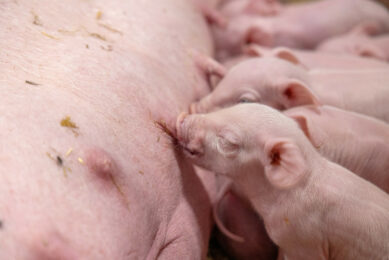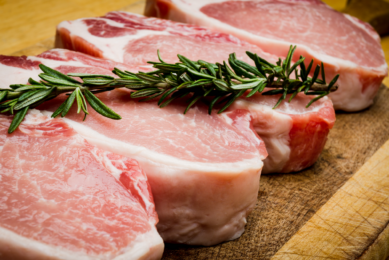Neal Matthews, PIC: “Achieving that perfect piece of pork”

Being a meat scientist at a breeding company requires a lot of patience. After all, most work focuses on a phase long before conception, yet the result that counts can only be fully appreciated after slaughter and processing. Neal Matthews, PIC, explains how careful genetic selection can lead to a delicious piece of pork.
Genetic companies have been breeding for improvements in litter size and feed efficiency for nearly three decades. Today’s genetics are capable of producing 30 pigs/sow/year and feed efficiencies less than 2.0 in terminal lines. While this genetic selection process has resulted in more efficient and sustainable pork production, it has not delivered a consistently tender, juicy pork product to the consumer.
Neal Matthews’ passion is trouble-shooting and problem-solving to help customers find the best way to realise all of their pig’s genetic potential and turn it into tender, juicy pork. His goal is to preserve the optimum pH level in the meat – a topic that is frequently met with scepticism. A current focus for PIC is looking at the value of primal cuts for producers and working to achieve a pork product that the consumer wants to purchase again and again.
Pig Progress: Why the increased emphasis on meat quality?
Neal Matthews: “You can be the best at efficient production but if the consumer doesn’t return again and again to purchase your product you have a problem. We realised the necessity of putting quality pork in the meat case for every purchase. To help achieve this goal, our focus has shifted to making direct genetic selection for primal values in the carcass and tenderness in the meat.
“Each week across multiple commercial facilities we are processing thousands of pigs with elite terminal line genetics. Backfat and loin depth measurements are being replaced with the actual weight and value of individual primal cuts in the selection index. Warner-Bratzler shear force measurements of loin chops after cooking are augmenting existing measures like marbling scores and ultimate pH in the terminal sire indices as well.
“Unfortunately, the genetics alone can’t overcome the 60% to 70% variation in pork quality that occurs during transportation, holding time, slaughter and carcass handling. We now understand that the trip to the processing plant can override the best genetics. That’s where my role as a meat scientist takes over.”
How does processing affect pork quality?
“In most cases, the pig farmer has less control over meat quality than the processing facility. You can have tremendous genetic potential and mess it up at the slaughter plant. As I visit slaughter plants for quality system reviews around the world, it’s often the simple steps that are the key to improving pork quality. Things like improving the lighting in areas where pigs are handled or moving pigs as a group to CO2 stunning versus individually to electric stunning.
“I enjoy solving the unique challenges of each system I encounter. It’s all about helping the facility realise the best return on product. You can improve the pH of the carcass simply by holding pigs three hours after delivery and before slaughter at the plant.
“Carcass chilling is another important factor in pork quality. Slow chilling negatively impacts pork quality by reducing the ultimate pH (pHu) and water holding capacity while blast chillers that quickly reduce carcass temperature help maintain optimal pH.”
Profile Neal Matthews, 47, an applied meat scientist for PIC, grew up on a small hobby farm near Lake Village, AR, United States. He became interested in meat quality while working as a butcher in the local supermarket during high school. With a PhD in swine nutrition focusing on nutritional manipulation of pork composition and quality, his current focus is on the role of pH and meat quality. He has visited slaughter facilities in more than 20 countries around the world working to help them optimise meat quality in their operations. After living for 2.5 years in Europe, he currently resides in the US. He was previously employed by Premium Standard Farms, an integrated company with more than 200,000 sows and 4 million slaughter pigs per year, as a technical services manager and meat scientist. Neal Matthews, 47, an applied meat scientist for PIC, grew up on a small hobby farm near Lake Village, AR, United States. He became interested in meat quality while working as a butcher in the local supermarket during high school. With a PhD in swine nutrition focusing on nutritional manipulation of pork composition and quality, his current focus is on the role of pH and meat quality. He has visited slaughter facilities in more than 20 countries around the world working to help them optimise meat quality in their operations. After living for 2.5 years in Europe, he currently resides in the US. He was previously employed by Premium Standard Farms, an integrated company with more than 200,000 sows and 4 million slaughter pigs per year, as a technical services manager and meat scientist. |
We hear a lot of talk about marbling in pork. How important is it?
“Marbling is important but it doesn’t play the same role as it does in beef. Research from the early 1990s advanced the theory that marbling was responsible for taste and tenderness. That is certainly true in beef. Today, we’re seeing more research looking at factors like pH, cooking temperatures and shear test values in addition to marbling.
“The results are interesting. There certainly is a genetic correlation between backfat and intramuscular fat or marbling in pork. And, yes, through breeding efforts over the past 30 years, pigs today generally have less marbling and, in some cases, are too lean.
“In general, the presence and role of marbling in pork has been overrated in the past ten years. Marbling levels of 2% are considered necessary for good eating quality, yet marbling levels greater than 2% don’t have a substantial effect on eating quality in the same way that pH levels do. For instance, a 0.1 change in pH in the meat is equal to a 4.6% change in marbling when comparing juiciness and tenderness of cooked pork. So you can see that it’s much easier to improve eating quality through pH than marbling, especially when pH values are very dependent on processing protocols.”
Can you explain the role of pH?
“Many people recognise the term marbling in relation to meat quality but they don’t normally hear the term pH used in conjunction with meat at the consumer level. The fact that pH plays a role in meat quality has been known for some time but we haven’t used it effectively in the marketing of high eating quality pork at the consumer level. The pHu of pork, measured 18-24 hours post mortem, is the pivotal trait and best predictor of pork quality due to its high correlation with sensory traits like tenderness and juiciness.
“In pork, pHu is related to water holding capacity, shelf life, glycolytic potential and tenderness. It also greatly influences profitability of the carcass. For instance, raising the pH from 5.5 to 5.8 increases carcass value by $ 1 per pig in retained water. The ideal pHu level for pork in the grocery case is 5.8 to 6.0 in the US. However, pHu values higher than 6.0 tend to lead to increased microbial growth.
“Yet the Japanese market requires high pH levels with more than 40 days of shelf life, and with proper interventions we are able to achieve this goal.”
How are genetics and pH related?
“There is no doubt that pHu is heritable and tied to genetics and we’ve continued to work on improving and optimising pH levels through our breeding programmes for more than 20 years.
“The pHu level and its impact on meat quality is the result of G + E, genetics plus environment. My field of applied meat science is addressing the E through multiple factors including nutrition, feed withdrawal times, welfare and stress management through loading, transportation and unloading, resting time at the packing plant, handling during stunning, stunning methods and carcass chilling conditions.”
Are you continuing to work on reducing boar taint?
“Through a grant in the EU we conducted research assessing boars with high and/or low estimated breeding values (EBVs) for androstenone and skatole. We know that genetics have a larger effect on androstenone levels while diet and environment more directly impact skatole. Through this research we verified that pigs with low EBVs for androstenone and skatole have reduced risk of boar taint. Skatole levels in the study were also reduced through nutritional compounds in feed rations. Customers interested in those Piétrain lines with reduced hormone levels are able to access them today at a premium.
“Despite reduced levels of boar taint, some processors in Germany aren’t happy with the carcasses from the Piétrain genetics. At processing, these boars produced bellies of reduced size and quality. Research also shows that selecting for low boar taint can have negative consequences in sow productivity. When selecting genetics to reduce boar taint and produce intact males, it’s a give and take depending on your market. Farmers need to make the decision that best fits their operation.”
What do you see as the biggest challenge to feeding the world in 2050?
“Society will need to embrace new technologies to meet the growing demand for animal protein in a sustainable way. As a food and agricultural industry, we will need to position science in a positive and constructive way. We need a message that is easy to explain and that people can understand.
“For instance, one technology with great potential is gene editing. This technology can help prevent the costly swine disease PRRS. New technologies often cause anxiety with consumers but through clear, accurate communication we can bring innovation to the food chain in a responsible way. We need to be better at highlighting the benefits and trade-offs of technology.”











